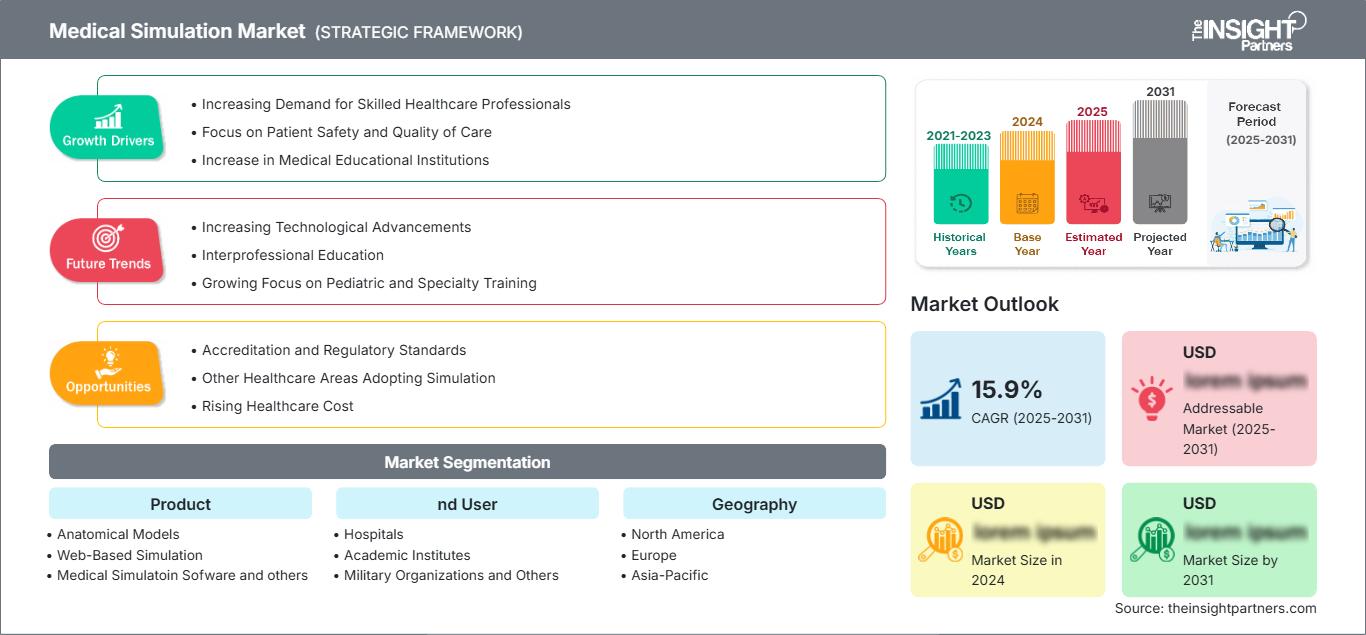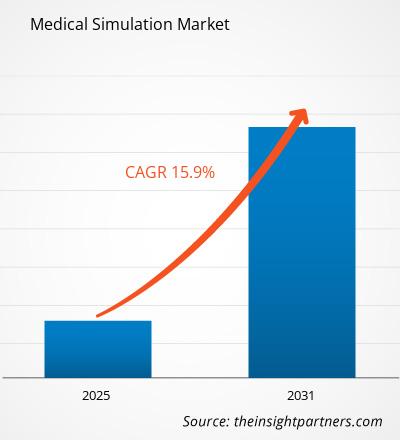Le marché de la simulation médicale devrait atteindre 5,34 milliards de dollars américains d'ici 2031. Il devrait enregistrer un TCAC de 13,2 % entre 2025 et 2031.
Le rapport est segmenté par produit (modèles anatomiques, simulation en ligne, logiciels de simulation médicale et autres) et par utilisateur final (hôpitaux, établissements d'enseignement, organisations militaires et autres). L'analyse mondiale est ensuite ventilée par région et par principaux pays. Le rapport présente les valeurs en dollars américains pour les analyses et segments mentionnés ci-dessus.
Objectif du rapport
Le rapport sur le marché de la simulation médicale, réalisé par The Insight Partners, vise à décrire le paysage actuel et la croissance future, les principaux facteurs de croissance, les défis et les opportunités. Cela permettra d'éclairer divers acteurs du marché, tels que :
- Fournisseurs de technologies/Fabricants : Pour comprendre l'évolution de la dynamique du marché et identifier les opportunités de croissance potentielles, afin de prendre des décisions stratégiques éclairées.
- Investisseurs : Pour réaliser une analyse approfondie des tendances concernant le taux de croissance du marché, les projections financières et les opportunités tout au long de la chaîne de valeur.
- Organismes de réglementation : Pour encadrer les politiques et les activités du marché afin de minimiser les abus, préserver la confiance des investisseurs et garantir l'intégrité et la stabilité du marché.
Segmentation du marché de la simulation médicale : Produits
- Modèles anatomiques
- Simulation en ligne
- Logiciels de simulation médicale et autres
Utilisateurs finaux
- Hôpitaux
- Établissements d'enseignement
- Organisations militaires et autres
Vous bénéficierez d’une personnalisation sur n’importe quel rapport - gratuitement - y compris des parties de ce rapport, ou une analyse au niveau du pays, un pack de données Excel, ainsi que de profiter d’offres exceptionnelles et de réductions pour les start-ups et les universités
Marché de la simulation médicale: Perspectives stratégiques

- Obtenez les principales tendances clés du marché de ce rapport.Cet échantillon GRATUIT comprendra une analyse de données, allant des tendances du marché aux estimations et prévisions.
Facteurs de croissance du marché de la simulation médicale
- Demande croissante de professionnels de santé qualifiés : Le secteur de la santé se diversifie et les professionnels bien formés y sont de plus en plus recherchés. La formation par simulation permet aux apprenants d'acquérir une expérience inégalée. Avec l'émergence de nouvelles technologies, de nouveaux traitements et de nouvelles politiques relatives aux soins des patients, la demande de professionnels de santé correctement formés est en hausse. Les technologies de simulation médicale offrent des environnements de formation en temps réel où les professionnels de santé peuvent développer leurs compétences sans mettre en danger la vie des patients.
- Priorité à la sécurité des patients et à la qualité des soins : Les erreurs médicales peuvent être à l'origine de graves incidents dans les hôpitaux. La formation par simulation améliore les compétences des professionnels de santé, la sécurité des patients et la qualité des soins, tout en réduisant les risques. La sécurité des patients et la qualité des soins étant aujourd'hui primordiales, les établissements médicaux s'appuient de plus en plus sur la formation par simulation afin que leur personnel soit parfaitement qualifié pour réaliser les procédures. Il en résulte des professionnels de santé mieux informés et une diminution mesurable des erreurs médicales.
- Augmentation du nombre d'établissements d'enseignement médical : Dans un nombre croissant d'écoles de médecine et de formations en soins infirmiers, la nécessité de former les étudiants avec des outils pédagogiques adaptés se fait sentir. La technologie de simulation permet aux établissements de former efficacement leurs étudiants. De plus, on observe une transition d'un enseignement magistral vers une formation par compétences axée sur l'expérience pratique et le réalisme. Pour répondre à ce besoin, les simulateurs médicaux se sont révélés être des outils efficaces pour cet apprentissage.
Tendances futures du marché de la simulation médicale
- Progrès technologiques croissants : L'utilisation accrue de la technologie dans les sessions de formation ouvre de nombreuses perspectives pour le développement des technologies de simulation, telles que les mannequins haute-fidélité, la réalité virtuelle (RV), la réalité augmentée (RA) et même la gamification. Ces technologies permettront aux apprenants de vivre des formations plus réalistes et plus captivantes. Les établissements d'enseignement médical tirent pleinement parti des nouvelles technologies pour élaborer leurs programmes, offrant ainsi à leurs étudiants les outils et les expériences les plus récents. Formation interprofessionnelle : Le secteur de la santé évolue rapidement vers une formation interprofessionnelle où les apprenants de différentes professions de santé suivent une formation conjointe. La formation par simulation favorise le travail d'équipe et la communication entre les professionnels de santé, contribuant ainsi à la collaboration interprofessionnelle. Sur le lieu de travail, elle permettra de lever les barrières entre les professions, facilitant ainsi une communication et un travail d'équipe efficaces. Intérêt croissant pour la formation en pédiatrie et dans les spécialités médicales : La demande de formation par simulation en pédiatrie et dans les spécialités médicales est toujours aussi forte ; la prise de conscience accrue des besoins spécifiques des enfants en matière de soins de santé contribue également à cette tendance. Cela a engendré une demande croissante de programmes de formation axés sur les compétences médicales spécifiques à la pédiatrie, car un même diagnostic qui peut paraître anodin chez l'adulte peut se révéler un problème totalement différent chez l'enfant et, par conséquent, nécessiter des approches de soins différentes.
Opportunités du marché de la simulation médicale
- Normes d'accréditation et réglementaires : De nombreux organismes accréditent les établissements de santé pour la formation par simulation dispensée dans le cadre de la résidence et du développement professionnel continu. De ce fait, de nombreux établissements d'enseignement médical adoptent l'utilisation de la technologie de simulation. De plus, la plupart des systèmes de formation en santé sont axés sur les compétences ; par conséquent, plusieurs programmes d'enseignement intègrent la simulation pour répondre aux normes d'accréditation, créant ainsi un besoin en solutions de simulation dans les établissements d'enseignement.
- Autres domaines de la santé adoptant la simulation : La simulation ne se limite plus à la formation médicale. Elle est également appliquée dans d'autres domaines, tels que la formation chirurgicale, les interventions d'urgence et la formation interprofessionnelle, ce qui élargit la portée du marché. Cela permet d'acquérir des compétences pratiques, tant procédurales que cognitives, dans un environnement réaliste et sans risque pour les patients ni pour le personnel des différentes spécialités.
- Coûts croissants des soins de santé : les programmes de formation en soins de santé proposés par les entreprises doivent être économiques et ne pas nécessiter de ressources coûteuses telles que des patients vivants ou d'autres méthodes de formation onéreuses, comme l'utilisation de cadavres. Cela permet non seulement de réduire les coûts de formation elle-même, mais aussi d'augmenter la fréquence des sessions de formation. La simulation peut éliminer le coût de la formation en situation de travail et améliorer les performances en général.
Marché de la simulation médicale
Les analystes de The Insight Partners ont analysé en détail les tendances régionales et les facteurs influençant le marché de la simulation médicale tout au long de la période prévisionnelle. Cette section aborde également les segments et la répartition géographique du marché de la gestion des troubles du rythme cardiaque en Amérique du Nord, en Europe, en Asie-Pacifique, au Moyen-Orient et en Afrique, ainsi qu'en Amérique du Sud et centrale.
Portée du rapport sur le marché de la simulation médicale
| Attribut de rapport | Détails |
|---|---|
| Taille du marché en 2024 | US$ XX Billion |
| Taille du marché par 2031 | US$ 5.34 Billion |
| TCAC mondial (2025 - 2031) | 13.2% |
| Données historiques | 2021-2023 |
| Période de prévision | 2025-2031 |
| Segments couverts |
By Produit
|
| Régions et pays couverts | Amérique du Nord
|
| Leaders du marché et profils d'entreprises clés |
|
Densité des acteurs du marché de la simulation médicale : comprendre son impact sur la dynamique commerciale
Le marché de la simulation médicale connaît une croissance rapide, portée par une demande croissante des utilisateurs finaux, elle-même alimentée par l'évolution des préférences des consommateurs, les progrès technologiques et une meilleure connaissance des avantages du produit. Face à cette demande grandissante, les entreprises élargissent leur offre, innovent pour répondre aux besoins des consommateurs et tirent parti des tendances émergentes, ce qui stimule davantage la croissance du marché.

- Obtenez le Marché de la simulation médicale Aperçu des principaux acteurs clés
Points clés de la vente
- Couverture exhaustive : Ce rapport analyse en détail les produits, services, types et utilisateurs finaux du marché de la simulation médicale, offrant ainsi une vision globale.
- Analyse d'experts : Ce rapport repose sur une connaissance approfondie du secteur et des analystes.
- Informations actualisées : Grâce à sa couverture des informations et tendances les plus récentes, ce rapport garantit la pertinence des données pour les entreprises.
- Options de personnalisation : Ce rapport peut être personnalisé pour répondre aux besoins spécifiques des clients et s'adapter parfaitement à leurs stratégies commerciales.
Ce rapport d'étude de marché sur la simulation médicale peut donc contribuer à décrypter et comprendre le contexte sectoriel et les perspectives de croissance. Malgré quelques points à améliorer, les avantages globaux de ce rapport tendent à surpasser ses inconvénients.
- Analyse historique (2 ans), année de base, prévision (7 ans) avec TCAC
- Analyse PEST et SWOT
- Taille du marché Valeur / Volume - Mondial, Régional, Pays
- Industrie et paysage concurrentiel
- Ensemble de données Excel
Rapports récents
Rapports connexes
Témoignages
Raison d'acheter
- Prise de décision éclairée
- Compréhension de la dynamique du marché
- Analyse concurrentielle
- Connaissances clients
- Prévisions de marché
- Atténuation des risques
- Planification stratégique
- Justification des investissements
- Identification des marchés émergents
- Amélioration des stratégies marketing
- Amélioration de l'efficacité opérationnelle
- Alignement sur les tendances réglementaires




















 Obtenez un échantillon gratuit pour - Marché de la simulation médicale
Obtenez un échantillon gratuit pour - Marché de la simulation médicale